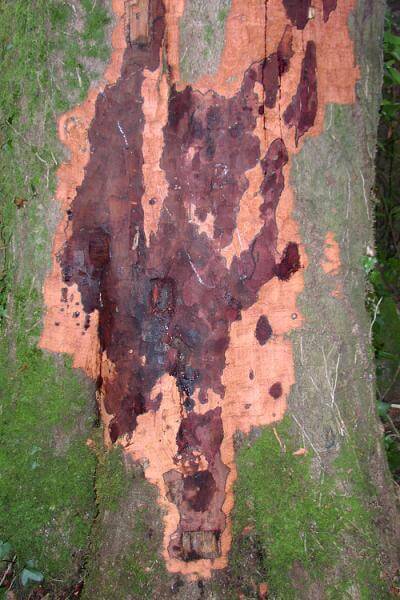
This pathogen is not yet established in North America but appears to pose a significant risk if it is introduced. This previously unknown pathogen was discovered in 2003 during surveys in Great Britain for the sudden oak death pathogen, Phytophthora ramorum. The origin of P. kernoviae is unknown. However, P. kernoviae has been on the Northern Island of New Zealand since at least the 1960s, where it is causing little damage (EPPO Alert 2009).
In Europe, P. kernoviae remains concentrated in Southwest England, although there are a few outbreaks in gardens in Scotland (Denman 2009). Unlike P. ramorum, P. kernoviae is found in only a few nurseries.
The most important environmental damage caused by P. kernoviae is to bilberry (Vaccinium myrtillus), which is widespread on the heathlands in the Southwest (Denman 09). Heathlands with many shrubs in the botanical family Ericaceae are considered an important habitat type in Europe; the U.K and Ireland harbor important examples of four of the seven recognized types. Britain and Ireland together support roughly 20% of the world’s lowland heathlands; the UK supports approximately 75% of the total (global) upland heathlands (European Union 2009). Apparently P. kernoviae has not spread to heathlands in other parts of northwestern Europe.
P. kernoviae also infects exotic Rhododendron species, especially R. ponticum. An infestation has been detected in rhododendrons in a forest location near the south coast of Ireland (Denman 2009).
The full host range of P. kernoviae is not known. In the United Kingdom, the tree species most heavily infected are Cankers have been reported primarily on Winter’s bark (Drimys winterii), Magnolia species, and Holm oak (Quercus ilex) (https://www.forestresearch.gov.uk/research/phytophthora-kernoviae/distribution-of-phytophthora-kernoviae/). A few plants in the following groups have also been infected: A small number (five or fewer trees) of other tree species have also been infected: Sweet chestnut (Castanea sativa), Michelia doltsopa, Cherry laurel (Prunus laurocerasus), and Podocarpus salignus. Single infections have been reported from tulip tree (Liriodendron tulipifera), Chilean hazelnut (Gevuina avellana) and ivy plant (Hedera helix) (https://www.forestresearch.gov.uk/research/phytophthora-kernoviae/distribution-of-phytophthora-kernoviae/). Other sources also list European beech (Fagus sylvatica), English holly (Ilex aquifolium), fetterbush (Pieris formosa), and additional oaks (Quercus ilex and Quercus robur) (Forestry Commission 2005). Several of these genera are found in North America: Fagus (beech), Quercus (oak), Rhododendron, Vaccinium and Magnolia. Of course, tulip tree is widespread in America’s eastern deciduous forests.
Trees generally become infected only when they are in close proximity to infected shrubs, especially rhododendrons. These trees are not contagious and can even recover from infection (https://www.forestresearch.gov.uk/tools-and-resources/pest-and-disease-resources/phytophthora-kernoviae/).
In several European countries, widespread infestation of Fagus (beech) stands with a variety of Phytophthora species. On beech, P. kernoviae exclusively occurs in the United Kingdom, where the humid climate facilitates spread from nearby Rhododendron plants. P. kernoviae is one of several species in the genus that are highly aggressive on the bark and root systems of both mature and young beech trees (Jung et al. 2018).
In 2014, Phytopthora kernoviae was also reported from Chile infecting Drimys winterii (winter’s bark). https://www.forestresearch.gov.uk/research/phytophthora-kernoviae/distribution-of-phytophthora-kernoviae/
In spring 2009, the UK Government decided (Walters 2009) to launch a 5-year program aimed at reducing the level of inoculum of both P. ramorum and P. kernoviae to epidemiologically insignificant levels. Program components include removal of the principal sporulating host – the exotic plant Rhododendron ponticum; and the identification and control of any new outbreaks in order to reduce the level of inoculum and minimize the risk of further disease development. There is also continuing research on the two pathogens, the diseases they cause, and more effective control measures. New funding at the level of £4m was allocated for the first 3 years of the program.
USFS scientists and managers developed a conservation priority-setting framework for forest tree species at risk from pest & pathogens and other threats. The Project CAPTURE (Conservation Assessment and Prioritization of Forest Trees Under Risk of Extirpation) uses FIA data and expert opinion to group tree species under threat by non-native pests into vulnerability classes and specify appropriate management and conservation strategies. The scientists prioritized 419 tree species native to the North American continent. The analysis identified 15 taxonomic groups requiring the most immediate conservation intervention because of the tree species’ exposure to an extrinsic threat, their sensitivity to the threat, and their ability to adapt to it. Each of these 15 most vulnerable species, and several additional species, should be the focus of both a comprehensive gene conservation program and a genetic resistance screening and development effort. The pathogen phytophthora kernoviaeis not known to be a threat to any of these 15 most vulnerable species.
Sources
Forestry Commission, 2005. Plant Health: Phytophthora kernoviae Frequently Asked Questions. At www.defra.gov.uk/planth/pkfaq.htm. Accessed on December 9, 2005. Link is no longer viable, try https://www.forestry.gov.uk/phytophthora instead.
European Plant Protection Organization. Phytophthora kernoviae Accessed January 2010.
European Union. 2009. Risk Analysis of Phytophthora ramorum, a Newly Recognised Pathogen Threat to Europe and the Cause of Sudden Oak Death in the USA
Jung, T., A. Pérez-Sierra, A. Durán, M. Horta Jung, Y. Balci, B. Scanu. 2018. Canker and decline diseases caused by soil- and airborne Phytophthora species in forests and woodlands. Persoonia 40, 2018: 182–220
Potter, K.M., Escanferla, M.E., Jetton, R.M., Man, G., Crane, B.S., Prioritizing the conservation needs of US tree spp: Evaluating vulnerability to forest insect and disease threats, Global Ecology and Conservation (2019), doi: https://doi.org/10.1016/
Walters, K. C. Sansford, and D. Slawson. 2009. Phytophthora ramorum and Phytophthora kernoviae in England and Wales – Public Consultation and New Programme. Fourth Sudden Oak Death Science Symposium June 2009
Webber, J. 2009. Phytophthora ramorum and Phytophthora kernoviae: An Update on Distribution, Policy, and Management in Europe. Fourth Sudden Oak Death Science Symposium June 2009



